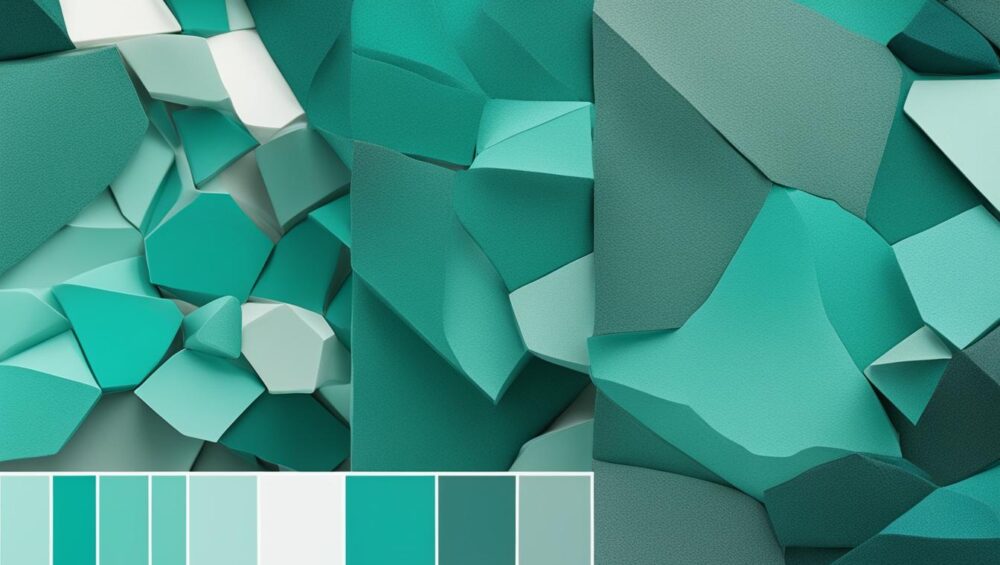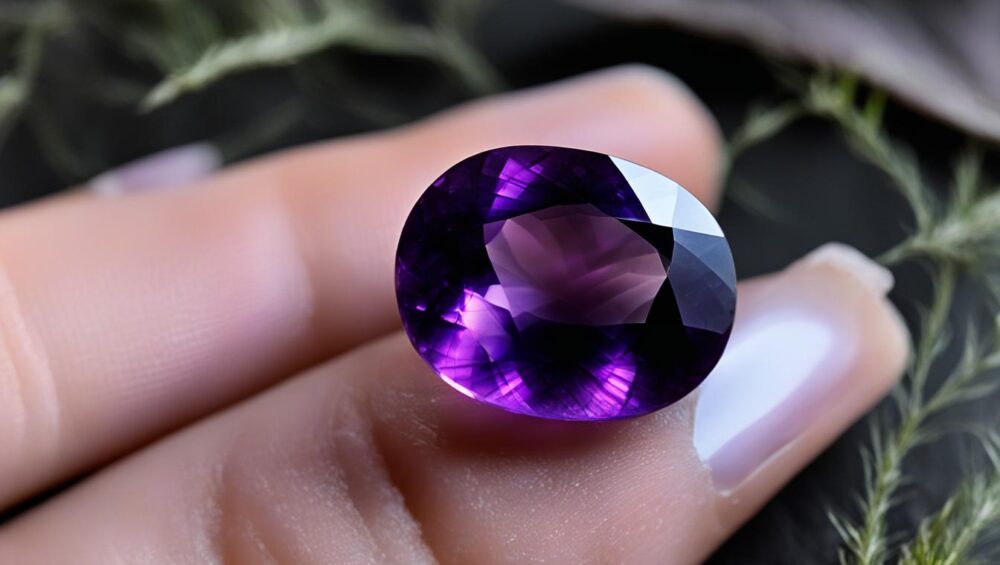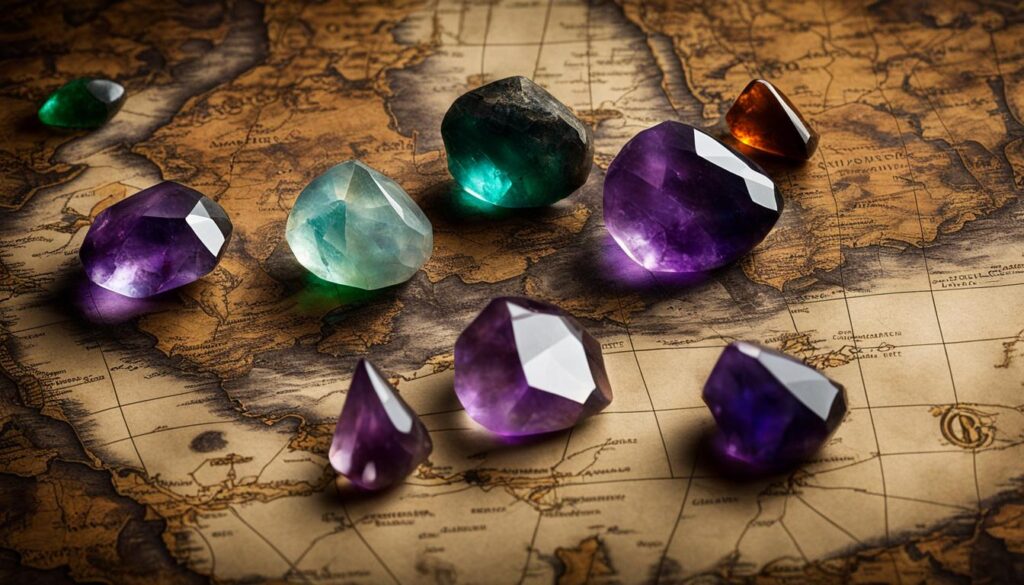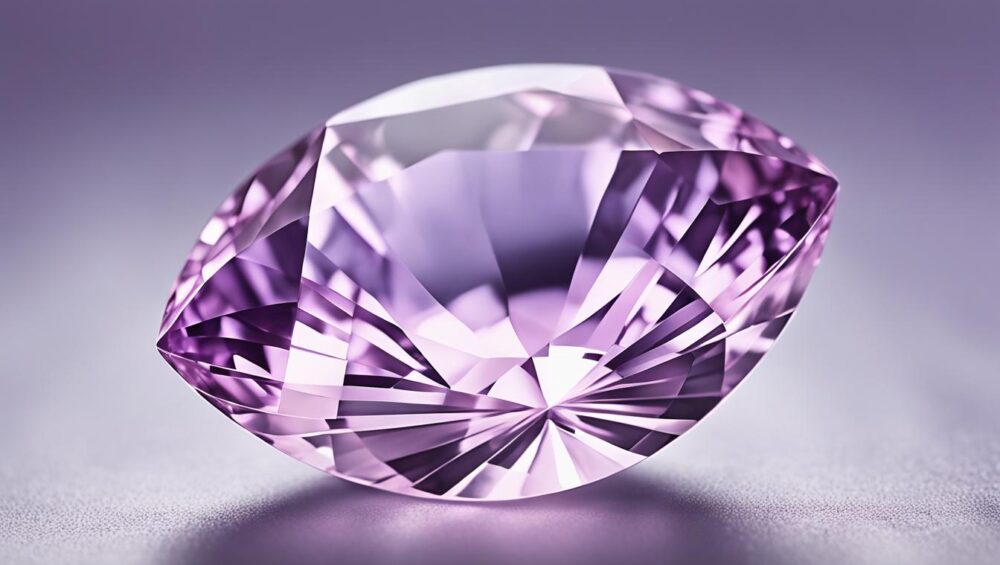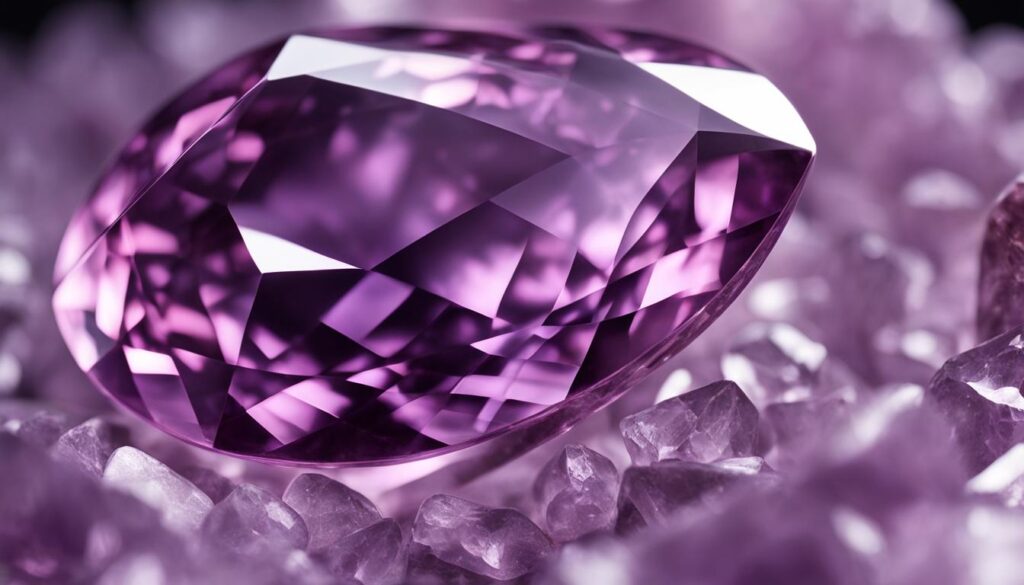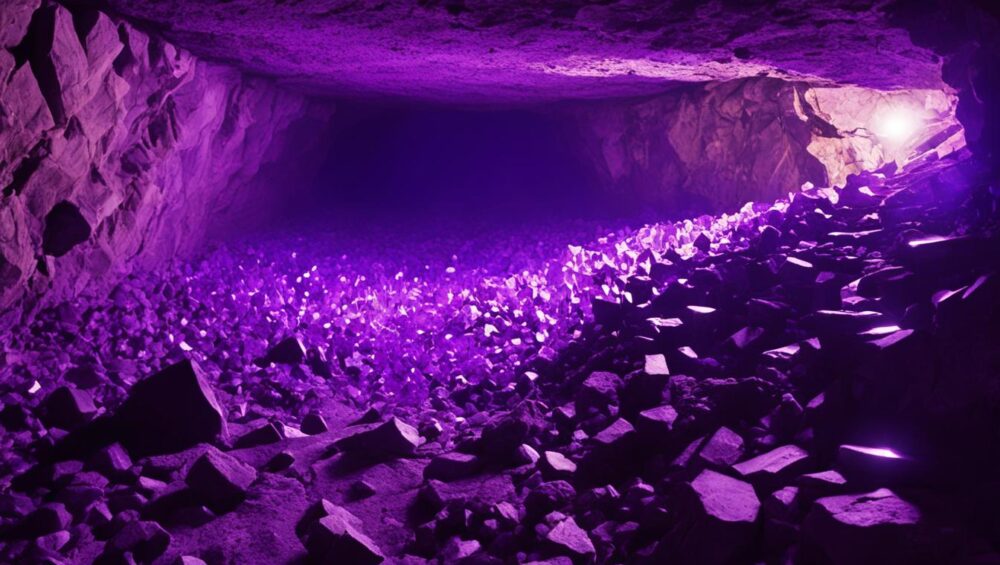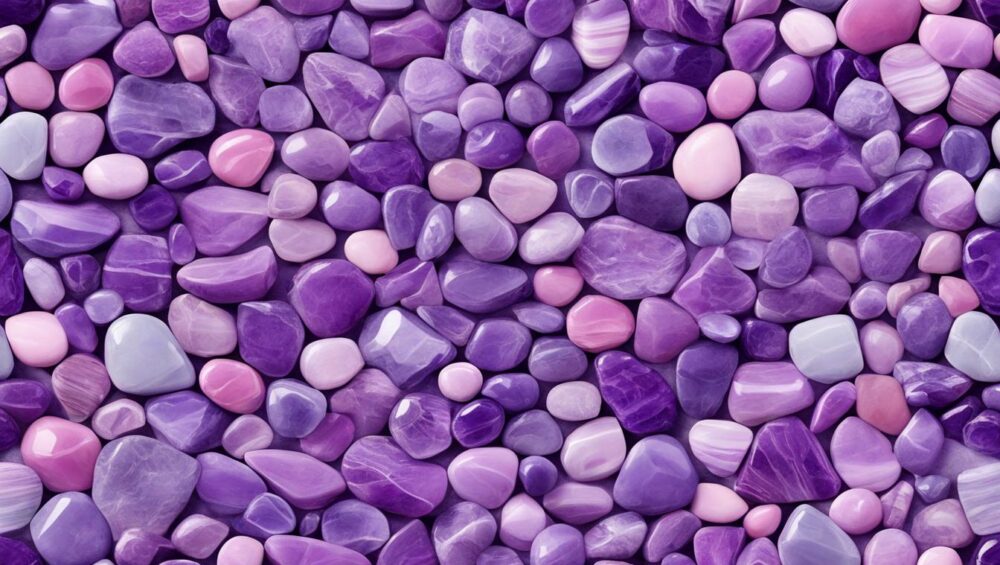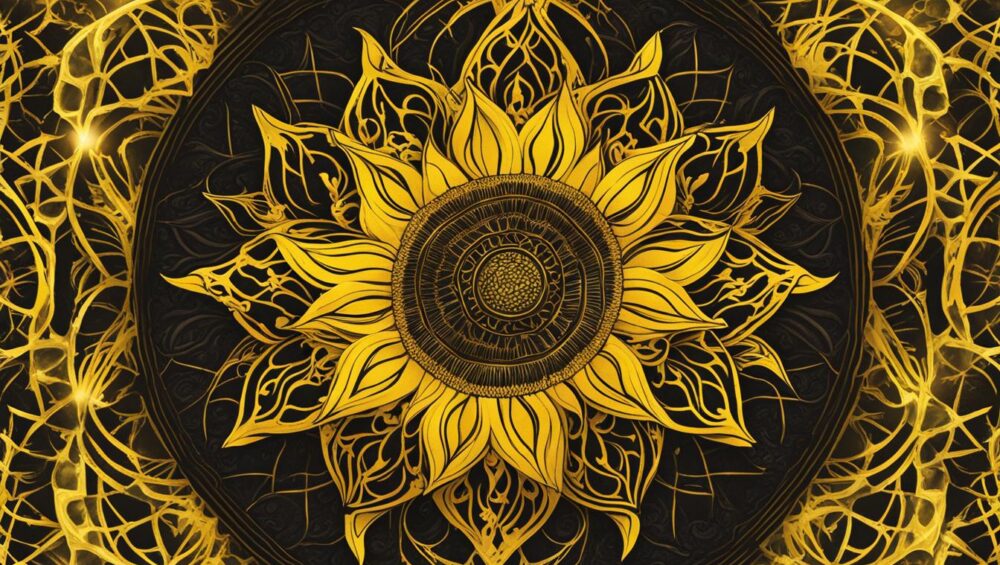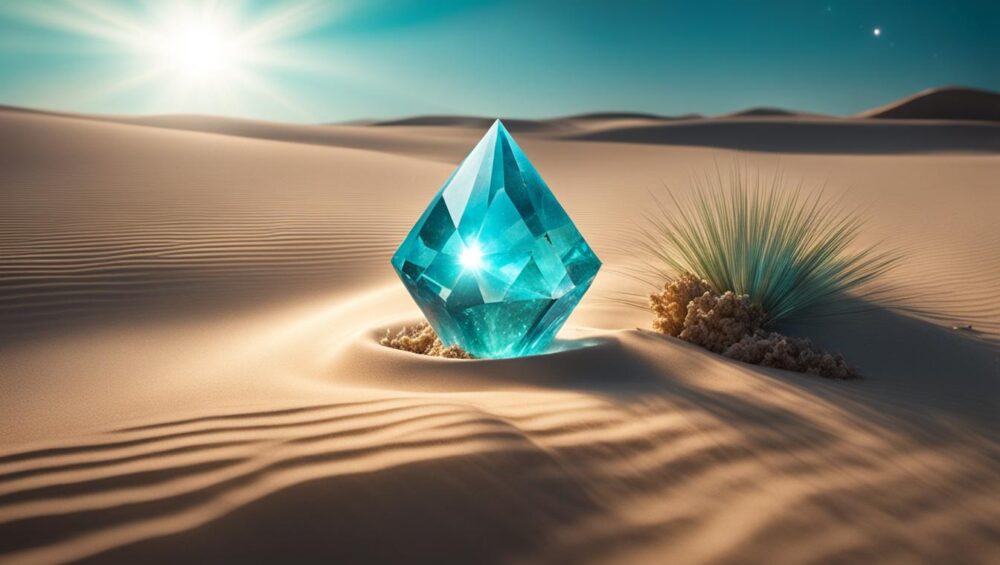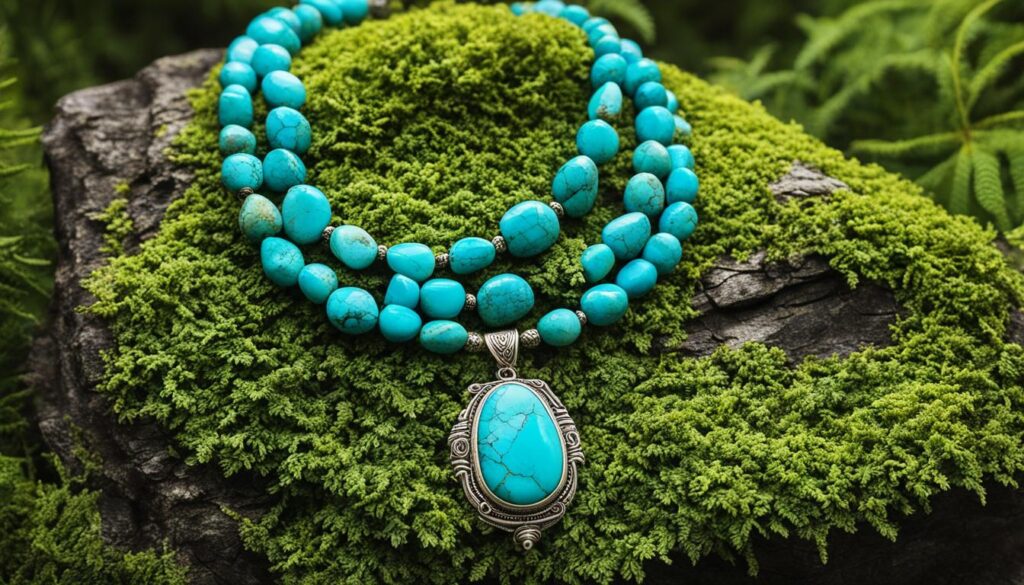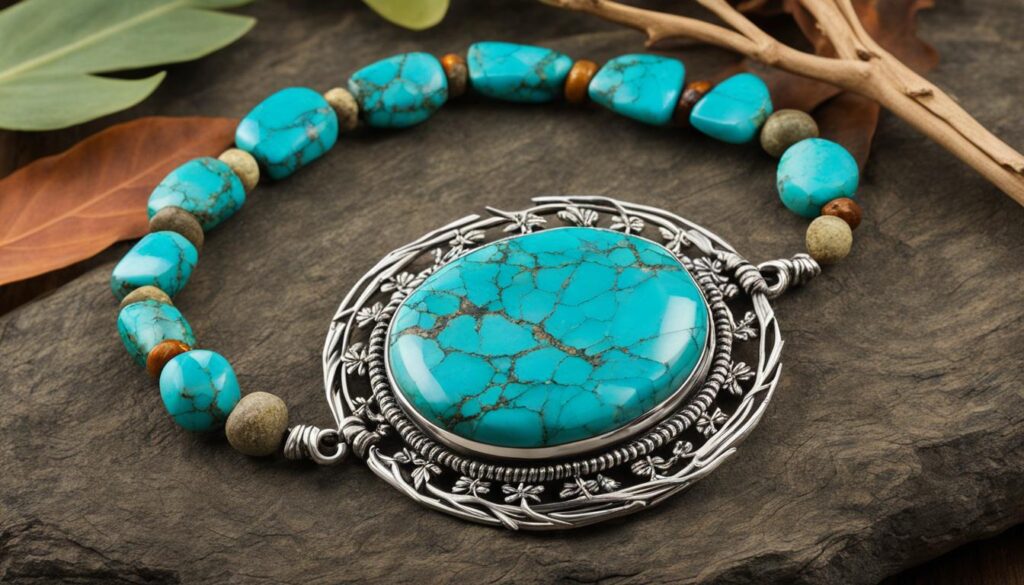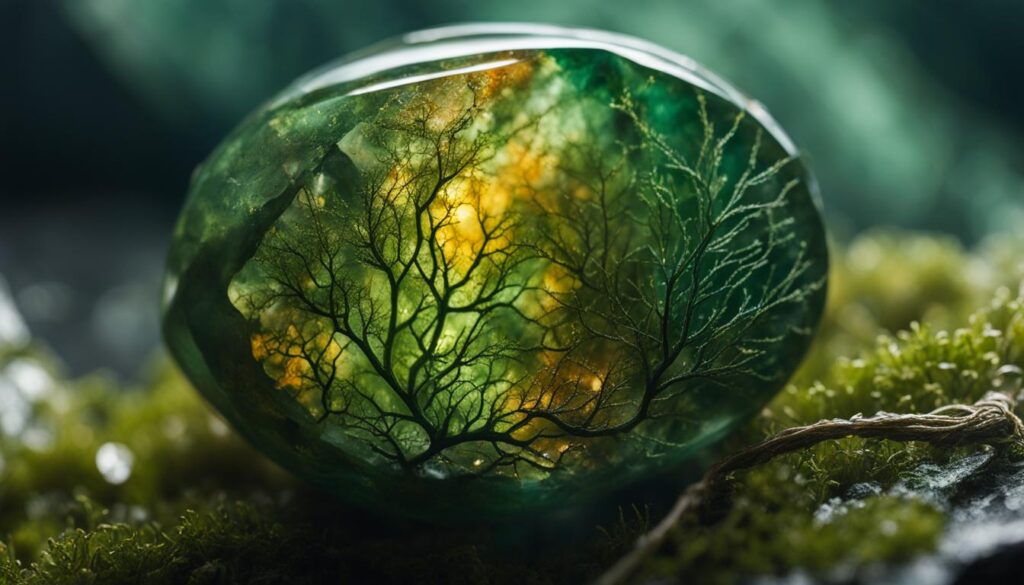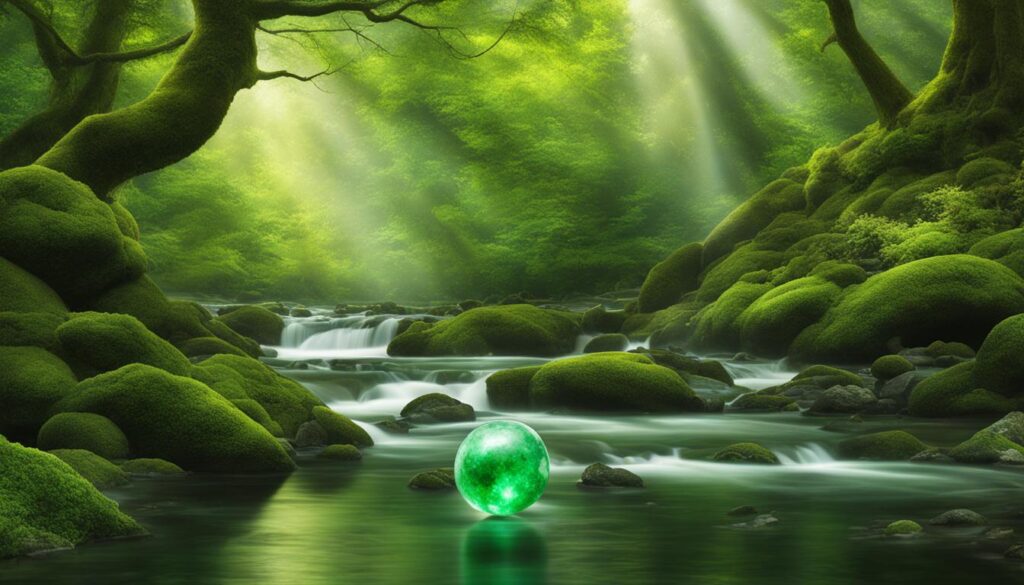Turquoise is a gemstone known for its vibrant colors and variations. It is a captivating blend of blue and green hues, derived from the presence of copper and other minerals. The color of turquoise can vary significantly based on the specific minerals and their quantities.
When it comes to turquoise, the possibilities are endless. This gemstone is available in various shades and combinations, offering a wide range of options for jewelry and design. From deep blues to bright greens, each shade of turquoise adds its own unique beauty to any piece.
Some of the most well-known types of turquoise include white buffalo turquoise, sleeping beauty turquoise, morenci turquoise, kingman turquoise, royston turquoise, carico lake turquoise, and bisbee turquoise. These varieties have their own distinct characteristics, making each piece of jewelry or artwork truly one-of-a-kind.
Key Takeaways:
- Turquoise is a gemstone with a mesmerizing blend of blue and green hues.
- The color of turquoise is determined by the presence of copper and other minerals.
- There are various shades and combinations of turquoise, offering a wide range of options for jewelry and design.
- White buffalo turquoise, sleeping beauty turquoise, morenci turquoise, kingman turquoise, royston turquoise, carico lake turquoise, and bisbee turquoise are some notable varieties of turquoise.
- Each type of turquoise has its own unique characteristics, making it a truly special gemstone.
How Does Turquoise Form?
Turquoise forms when certain geological conditions are met. Rainwater, copper, and phosphate minerals are necessary for turquoise formation. As rainwater trickles down through cracks in the earth’s surface, it carries copper and minerals with it. Over time, these minerals dissolve, resulting in the formation of turquoise. The blue and green hues of turquoise come from the oxidation of copper.
“Rainwater, copper, and phosphate minerals are necessary for turquoise formation.”
Turquoise formation is a fascinating process that occurs deep within the Earth’s crust. It starts with rainwater seeping into the ground and finding its way into cracks and crevices in rocks. As the water infiltrates these spaces, it carries with it small amounts of copper and phosphate minerals.
“Rainwater, copper, and phosphate minerals are necessary for turquoise formation.”
Over time, this water-transported copper and minerals interact with the surrounding rocks, gradually dissolving and creating a solution rich in copper and phosphates. As the solution continues to percolate through the rocks, it eventually reaches a point where the necessary conditions for turquoise formation are met.
The minerals in the solution, now saturated with copper and phosphates, begin to crystallize and solidify. The resulting formation is none other than turquoise, with its distinctive blue and green colors.
The precise conditions required for turquoise formation can vary depending on factors such as temperature, pressure, and the specific chemical composition of the surrounding rocks. These conditions are often found in arid or semiarid regions, where rainwater is scarce but occasional downpours can create the perfect environment for turquoise to form.
It’s important to note that turquoise formation is a slow and gradual process, taking millions of years. The intricate combination of rainwater, copper, and phosphate minerals must occur under the right circumstances for turquoise to develop.
Turquoise Formation: Key Points
- Rainwater, copper, and phosphate minerals are necessary for turquoise formation.
- As rainwater seeps into the ground, it carries small amounts of copper and minerals.
- The water-transported copper and minerals dissolve, creating a solution saturated with copper and phosphates.
- Over time, the minerals in the solution crystallize and solidify, resulting in turquoise formation.
- Turquoise formation requires specific conditions, such as temperature, pressure, and the chemical composition of the surrounding rocks.
- The process takes millions of years to complete.
The Conditions for Turquoise Formation
| Conditions |
Description |
| Availability of Rainwater |
Rainwater is the primary source of the necessary minerals for turquoise formation. |
| Presence of Copper |
Copper is a vital component in the formation of turquoise, contributing to its distinct blue and green hues. |
| Phosphate Minerals |
Phosphate minerals play a crucial role in the crystal growth and solidification processes of turquoise. |
| Temperature and Pressure |
The specific conditions of temperature and pressure within the Earth’s crust influence the formation of turquoise. |
| Chemical Composition of Surrounding Rocks |
The rocks surrounding the turquoise formation site contribute to the overall chemical makeup and color variations of the turquoise. |
Different Types of Turquoise
There are several different types of turquoise, each with its own unique characteristics. Let’s explore some of the most popular types:
Sleeping Beauty Turquoise
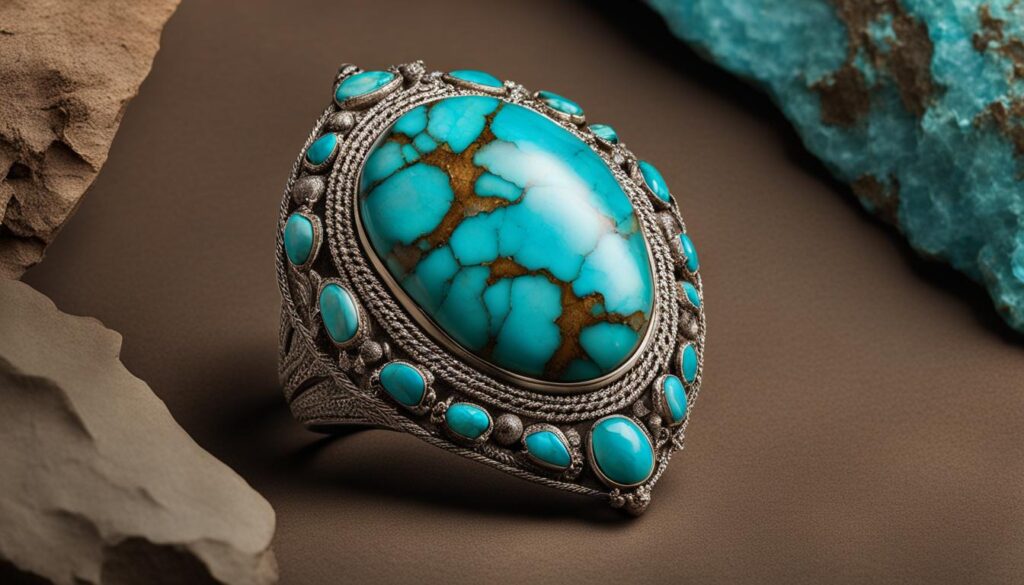
Sleeping Beauty Turquoise is known for its rich, vibrant blue color. It is highly prized for its uniformity and lack of matrix, making it a popular choice for jewelry.
Kingman Turquoise
Kingman Turquoise comes from the Kingman Mine in Arizona, USA. It exhibits shades of blue and green with white or black matrices, creating a beautiful contrast. Kingman Turquoise is cherished for its unique color variations.
Bisbee Turquoise
Bisbee Turquoise is named after the Bisbee mine in Arizona, which was once the largest producer of copper in the United States. It is valued for its “Bisbee blue” color, which ranges from deep blue to blue-green with striking black or brown matrix patterns.
Royston Turquoise
Royston Turquoise is mined in Nevada, USA, and is known for its exceptional color range. It can display a variety of turquoise and mineral matrices, creating intricate patterns and unique designs.
Morenci Turquoise
Morenci Turquoise is characterized by its deep blue color and the presence of pyrite veins. It is one of the most popular types of turquoise and is highly sought after by collectors and jewelry designers.
Carico Lake Turquoise
Carico Lake Turquoise is named after the Carico Lake mine in Nevada, USA. It is known for its distinctive lime green color, which sets it apart from other types of turquoise. Carico Lake Turquoise is favored for its unique and vibrant hue.
White Buffalo Turquoise
White Buffalo Turquoise is technically not turquoise but is commonly labeled as such. It is a white stone with black or brown matrices, resembling the patterns found in traditional turquoise. White Buffalo Turquoise is known for its striking and unique appearance.
Geographic Findings
Turquoise, a coveted gemstone, has a rich history rooted in mining and exploration. Its origins can be traced back thousands of years, with the earliest known use of turquoise dating back to 3,000 BCE in Egypt. However, it was the Persians who played a significant role in promoting the trade and mining of this precious stone, especially in modern-day Iran.
Today, turquoise is sourced from various parts of the world, each location offering its unique characteristics and qualities. Let’s explore some of the prominent turquoise mining locations and sources:
1. United States: The United States is a significant producer of turquoise, with several states renowned for their turquoise mines. The Southwest, particularly Arizona, Nevada, and New Mexico, is home to a vast array of turquoise deposits. Notable mines include the famous Kingman mine in Arizona, known for its vibrant blue hues, and the Sleeping Beauty mine in Arizona, famous for its pure sky blue turquoise.
2. China: China has a long history of turquoise production, with the Hubei Province being a prominent source. Chinese turquoise often showcases unique matrix patterns, making it highly sought after by collectors and jewelry designers.
3. Tibet: Turquoise mining has been a traditional practice in Tibet. The Tibetan plateau yields turquoise with distinct greenish-blue hues and intricate matrix patterns.
4. Australia: The Southern Cross Turquoise Mine in Queensland, Australia, is known for producing high-quality turquoise with vibrant blue and green color variations.
5. Chile: Chile is home to the world-famous Chuquicamata mine, known for its remarkable turquoise specimens. Chilean turquoise often exhibits a striking blue color with intricate matrix formations.
6. Brazil: Turquoise can be found in Brazil, particularly in the states of Minas Gerais and Bahia. Brazilian turquoise is admired for its beautiful blue and green hues.
7. Afghanistan: The remarkable Sar-e-Sang mine in Afghanistan has been producing turquoise for centuries. Afghan turquoise is highly valued for its deep blue color and exceptional quality.
The table below provides an overview of these turquoise mining locations:
| Location |
Notable Mines |
Characteristics |
| United States |
Kingman mine, Sleeping Beauty mine |
Vibrant blue hues, pure sky blue turquoise |
| China |
Hubei Province |
Unique matrix patterns |
| Tibet |
N/A |
Distinct greenish-blue hues, intricate matrix patterns |
| Australia |
Southern Cross Turquoise Mine |
Vibrant blue and green color variations |
| Chile |
Chuquicamata mine |
Blue color with intricate matrix formations |
| Brazil |
Minas Gerais, Bahia |
Beautiful blue and green hues |
| Afghanistan |
Sar-e-Sang mine |
Deep blue color, exceptional quality |

Turquoise Color and Properties
Turquoise is a mesmerizing gemstone that showcases a delightful range of colors, ranging from soothing blue to enchanting greenish blue. The stunning color variations of turquoise are a result of the presence of different minerals. Key minerals such as copper, chromium, vanadium, and iron interact to create a symphony of captivating hues in this gemstone.
The most highly valued turquoise is characterized by an intense, medium blue color that is even and consistent throughout the stone. This vibrant shade of blue is considered the epitome of turquoise beauty and is highly sought after by gemstone enthusiasts and jewelry connoisseurs alike.
In addition to its enchanting color palette, turquoise possesses a unique set of properties that add to its allure. On the Mohs Scale of hardness, turquoise ranges from 5 to 6, making it relatively soft compared to other gemstones. This level of hardness lends a delicate charm to turquoise jewelry, while also requiring gentle care and protection to maintain its integrity.
Turquoise exhibits various lusters, including vitreous (glass-like), waxy, and earthy. These different lusters contribute to the gemstone’s visual appeal, offering a diverse range of finishes to suit individual preferences and design aesthetics.
Another noteworthy characteristic of turquoise is its tendency to exhibit uneven or conchoidal fractures. These distinctive fracture patterns create intriguing textures and surface irregularities, adding a touch of natural beauty and uniqueness to each piece of turquoise.
Properties of Turquoise:
- Turquoise colors: Blue to greenish blue
- Valuable Color: Even, intense, medium blue
- Mohs Scale Hardness: 5-6
- Lusters: Vitreous, waxy, earthy
- Fracture Patterns: Uneven, conchoidal
No wonder turquoise has been cherished and celebrated throughout history for its striking color variations and captivating properties. It has found its place in a wide range of jewelry designs, from delicate necklaces to intricate earrings and stunning rings. The beauty and allure of turquoise continue to captivate hearts and dazzle eyes, offering a timeless charm that never goes out of style.
Turquoise Patterns and Inclusions
Turquoise is known for its stunning patterns and unique inclusions, which contribute to its exceptional beauty and allure. These distinct characteristics make each turquoise gemstone truly one-of-a-kind.
One of the most sought-after turquoise patterns is spiderweb turquoise. This captivating variety features delicately woven fine seams of matrix that form a mesmerizing web-like pattern. The intricate matrix in spiderweb turquoise adds visual interest and depth, enhancing the overall aesthetic appeal of the gemstone.
In addition to spiderweb turquoise, there are other notable patterns found in this gem. Birdseye turquoise showcases small circular or oval-shaped markings resembling the eyes of a bird. Boulder turquoise is characterized by the presence of host rock inclusions, creating a captivating contrast between the vibrant turquoise and the natural matrix. Seafoam turquoise exhibits a soft and swirling pattern, reminiscent of gentle ocean waves.
Matrix, often referred to as the “mother rock,” is the surrounding rock material that can be found within turquoise. While the presence of matrix can affect the overall value of turquoise, it also adds to its charm and design possibilities. Matrix patterns in turquoise can range from intricate veins to bold patterns, creating a visually appealing contrast against the vibrant blue and green hues of the gemstone.
“The matrix in turquoise adds a unique touch to jewelry designs, allowing for creative combinations and captivating aesthetics.”
Comparison of Turquoise Patterns and Inclusions
| Turquoise Pattern or Inclusion |
Description |
| Spiderweb Turquoise |
Delicate web-like patterns formed by fine seams of matrix. |
| Birdseye Turquoise |
Small circular or oval-shaped markings resembling bird eyes. |
| Boulder Turquoise |
Host rock inclusions creating a contrast with the turquoise. |
| Seafoam Turquoise |
Soft and swirling patterns reminiscent of ocean waves. |
| Matrix Patterns |
Intricate veins and bold designs created by the presence of matrix. |
The unique patterns and inclusions found in turquoise make it a highly desirable gemstone for jewelry designs. Whether it’s the delicate web-like pattern of spiderweb turquoise or the contrasting matrix inclusions, each piece of turquoise tells a story and adds a touch of natural beauty to any jewelry collection.
Conclusion
Turquoise is a truly captivating gemstone that showcases the beauty of nature’s palette. With its wide range of colors and variations, turquoise has been embraced and cherished for centuries, especially in the realm of jewelry. Designers and collectors alike are drawn to the enchanting allure of turquoise, appreciating its unique characteristics and the endless possibilities it offers.
Exploring the different types of turquoise allows for a deeper appreciation of this gemstone’s diversity. From the traditional blue hues to the striking green variations, each type of turquoise exhibits its own distinct beauty. Whether it’s the serene elegance of Sleeping Beauty turquoise or the vibrant allure of Kingman turquoise, there is a shade and style of turquoise jewelry to suit every taste and occasion.
The remarkable patterns and inclusions found in turquoise further enhance its appeal. Whether adorned with the delicate marvel of spiderweb patterns or the intriguing matrix that tells the story of its formation, turquoise jewelry becomes a wearable work of art. This gemstone not only captivates the eye but also carries a rich heritage and symbolism, making it a cherished choice for both personal adornment and meaningful gifts.
In conclusion, turquoise is a gemstone that embodies natural beauty and is appreciated for its captivating aesthetics. From its mesmerizing colors and patterns to its diverse range of jewelry options, turquoise continues to enchant and inspire. Whether worn as a statement piece or incorporated into intricate designs, turquoise jewelry is a timeless symbol of both individuality and appreciation for the wonders of nature.
FAQ
What colors does turquoise come in?
Turquoise comes in a range of colors, from blue to greenish blue.
What are the different shades of turquoise?
Turquoise can vary in color depending on the minerals present, ranging from light blue to deep blue, greenish blue, and even lime green.
What are the various colors of turquoise?
Turquoise can appear in shades of blue, green, and a combination of both, resulting in unique hues and color variations.
Are there different variations of turquoise?
Yes, there are different variations of turquoise based on the presence of various minerals and their quantities.
What are the options for turquoise hues?
Turquoise hues range from blue to greenish blue, offering a variety of options for different preferences.
Is there a specific turquoise color palette?
While there is no fixed color palette, turquoise encompasses a spectrum of blue and green shades.
Source Links

